Sound performances
For this review, I chose to pair the FiiO KA5 with the HiFiman Svanar, the FiiO FA7S, and the lovely Beyerdynamic’s DT 900 Pro X – the same in-ear/ headphones I used for my DC04PRO review. If the Hifiman is a bit too higher-end for this DAC, the FiiO is more than adequate and paired quite nicely with the KA5, and regarding the Beyerdynamic, I’ve got not much to say: it’s amazing for the price.
As for the source, I kept my MacBook and iPhone, combined with the ddHiFi TC28i and FiiO’s default cables, For the files, I mainly used Apple Music Hi-Res stream and Spotify, as I ended up using the KA5 almost exclusively on the train, or at the office.
Overall signature
So, how does FiiO’s new USB dongle compare to its smaller brother, the KA3, and contender like the DC04Pro? Quite nice actually, thanks to minor sound tweaks, and a major tonal upgrade
Power-wise, it’s still not on par with the DC06, which remains the most powerful dongle I tried yet, but, apart from the insensitive Hifiman Svanar – which needs a LOT of current to be correctly driven – almost all of the IEMs I paired with the FiiO KA5 scaled quite nicely. In fact, even if you were to stick with the single-ended port, you’d be surprised by how much juice the FiiO was able to extract from the USB source.
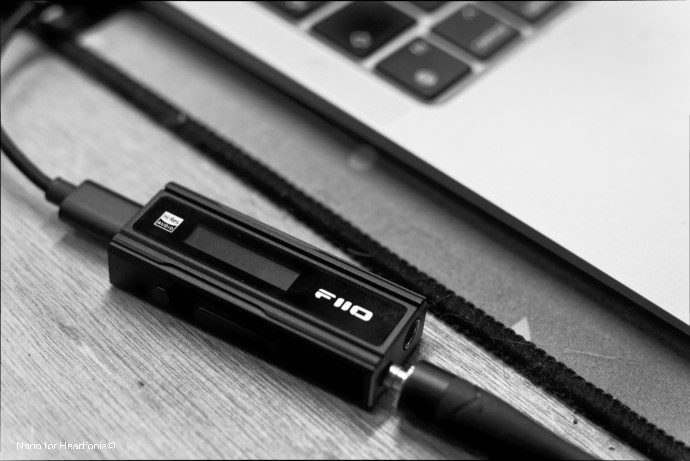
Head to head with the KA3 though, the new models easily takes the edge with better texture and cleaner lows whilst listening at high volume. In fact, on A beautiful mine from RJD2, the drums were a lot more life-like and every rimshot ringed in my ears for a lot longer, with less fatigue. It’s precise and dynamic, so bad recordings are not welcome, as the experience will turn out for the worst. There are small improvements here and there, without any real downsize: better dynamics overall, better bass control, improved high-mids, and with the FiiO FD7 the result was stunning more than once.
Surprisingly powerful despite the official number, the small DAC was able to drive my Beyerdynamic DT900 Pro X more than comfortably, giving me more headroom than before, through the 3.5mm headphone output. Once again, paired with this headphone, the result was simply stunning with deep lows, crisp highs, and a wide(r) soundstage, definitely outperforming the FiiO KA2 and KA3 this time.
And if the previous model already surprised me with its output power, the FiiO KA5 raises the bar even higher, driving my headphones almost effortlessly. Add to that the 4.4mm Pentaconn output paired with the volume control + screen , and for my use, this one is simply perfect for my use: I could switch between each of my three reviews IEMs/Headphones, and check what volume level I needed to drive them correctly.
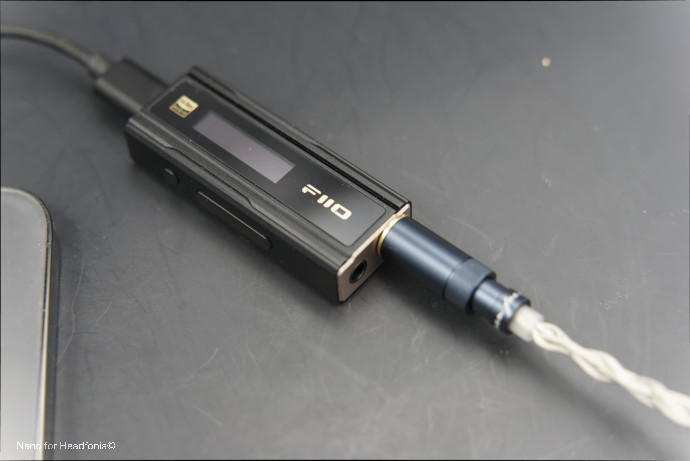
To my surprise, when compared to the iBasso DC04Pro, I didn’t ear much of a difference in terms of power. With the Beyer, the FiiO sounded more constrained, but in balanced mode, paired with the Hifiman Svanar, the KA5 took the edge over the DC04Pro – which was completely unexpected.
But, obviously, you don’t get the KA5 to drive big planars like the Audeze LCD-X, or power-hungry IEMs like the Svanar. Paired with a FiiO FD7 though, the end result was superb and the sheer sound pressure of the combo gave me real goosebumps. For a small on-the-go combo, it’s utterly impressive. This was especially true with dynamic, bass-hitting, tracks like The Age of Love remix from Charlotte De Witte & Enrico Sangiuliano, where some drums seemed to popup right into my face.
And, fed with high-resolution files, the FiiO KA5 offers a very high level of resolution and scales up easily. The mids are clean, sharp and detailed, with a good level of air outlined by low distortion and a linear signature – even if highs tends can appear slightly more present than usual. Moreover, the tonal signature differs from the usual mid-centric one found on the KA3/KA2/KA1.
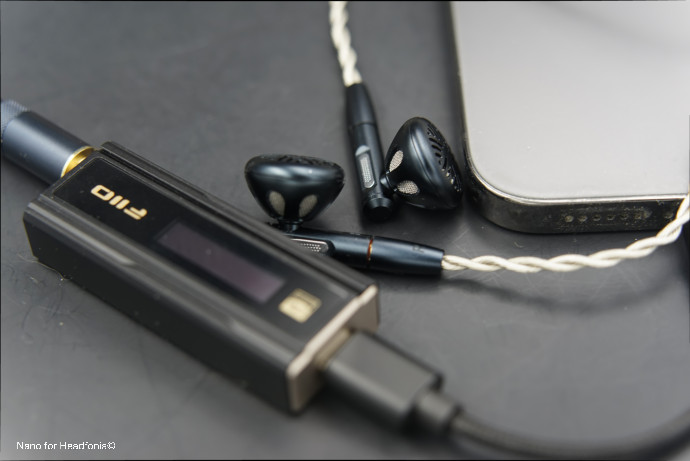
Despite being sharp and clinical, the trebles are not hissy and still sound softer compared to the ESS Sabre found in other devices. The lows are deep and fast, attaining the lowest notes and sub-rumble fitted so you can reach that good old toe-tapping Oomph. Truth be told, that might also be thanks to the DT900 Pro-X. In fact, if you haven’t listened to any of the modern FiiOs, you’d be surprised to find out that the previous mid-focused signature is now gone.
The FiiO KA5 sounds very neutral, with a wide sound stage and very good layering: with the right headphone/earphone you can spot each instrument and each singer with ease and there is no channel imbalance to ruin the experience. Better dynamic range, blacker background, with the same level of clarity and accuracy, which makes it a far better choice for IEMs users.
On top of that, and as promised in the product sheet, the KA5 is absolutely dead silent, even with sensitive IEMs like the FiiO FA7S. It’s a little more hissy than the iBasso DC04Pro, but that’s only if you were to leave the DAC idle, with ultra-sensitive IEM, and get a direct face-to-face comparison with the KA5. The only time I heard some parasites, was when my phone had to catch up with the old edge bandwidth, but that only occurred once.
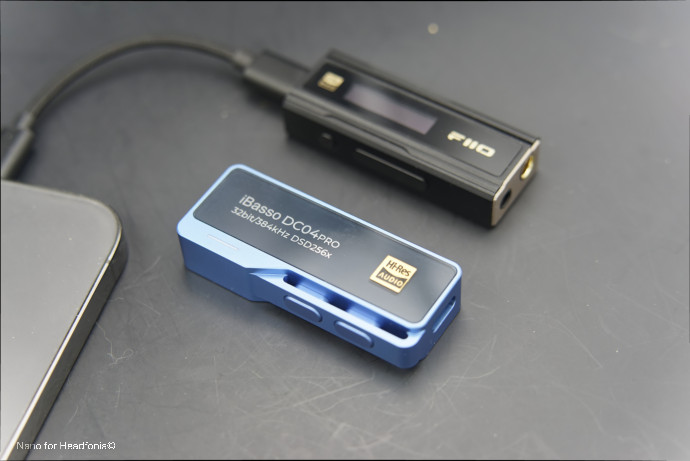
.A real upgrade and an excellent DAC/AMP in every regards sonically. Even more for the asked price!
Tonality
Highs: just on the spot, most of the time. The KA5 shows an ever so slight upper-mid boost, as all Cirrus-Logic DAC usually display. If that gives a sensation of precision, it can also lead to some sibilant on sensible headphones, but fortunately none of that was found on the DAC, and even when I pushed the volume up to unsafe levels, I never encountered any issue.
Good test track : Anthler – Polynation
Mids: open and linear, as usual. Vocals and acoustic tracks were an easy job for the KA5, even more once paired with a good IEM. FiiO has always nailed this part and the DAC/AMP makes no exception. The sound stage is wide and voices glided easily into my ears, especially paired with the FiiO FD7, as the two devices seemed to pair really, really, well. Of course, you could also pair the KA5 with the JD7, but if you can grab a set of FD7, go for it.
Good test track: Between a smile and a tear
Bass: powerful lows. FiiO has nailed the low end on their last models and the KA5 really beats all of its predecessor in that regard. Even in single-ended mode, the FiiO KA5 never lost composure and always offered a tight, fast bass – but going through its 4.4mm Pentaconn output really pushes thing on a superior level. There is no shallow echo nor dragging sensation, and with Dolby Atmos tracks on Apple Music, the whole new 3D effect gave a completely different experience, for the best.
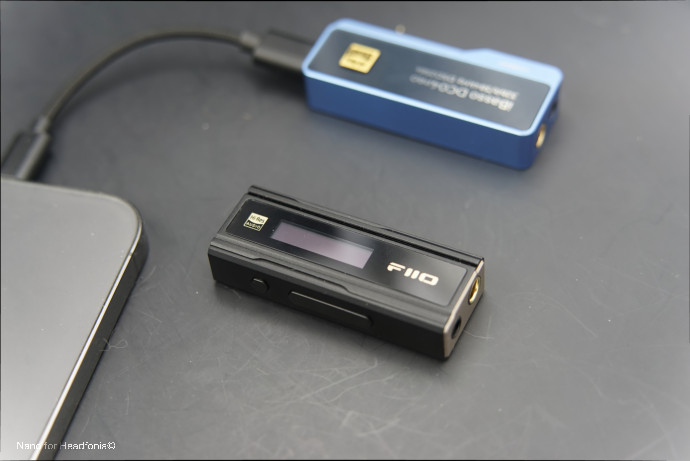
Conclusion
The FiiO KA5 is the perfect update to the might-but-sturdy KA3. Sound-wise, it’s better on every level, polishing the previous formula with various enhancements like tougher lows, or a wider but sharper soundstage. And if the sound prowess were not enough already, you can top that with praise-worthy build quality, an excellent screen, a complete bundle, and a conception design that makes it the perfect companion for any of your digital source – heck, it even works on the PS5.
Then the real question would be : this or the iBasso DC04Pro, another great DAC/AMP, equally priced? In my opinion, both excels in their own manner, and if the iBasso seems to outmatch the FiiO in single-ended mode, in balanced mode, they are evenly matched. In terms of ergonomic though, the KA5 clearly takes the edges, thanks to its screen.
So yeah, this new FiiO earns an award too, but if you ask me to choose between the KA5 and DC04Pro, it will be up to your personal tastes, plain and simple. The FiiO KA5 is now featured in our Recommended Buy DAC/AMP list!
Pros :
- sleek design and OLED screen
- low power consumption and excellent power reserve in balanced mode
- superb sound with enhanced performances compared to the KA3
- Many software options, via app or the device.
Cons :
- high mids can be a bit too pronounced





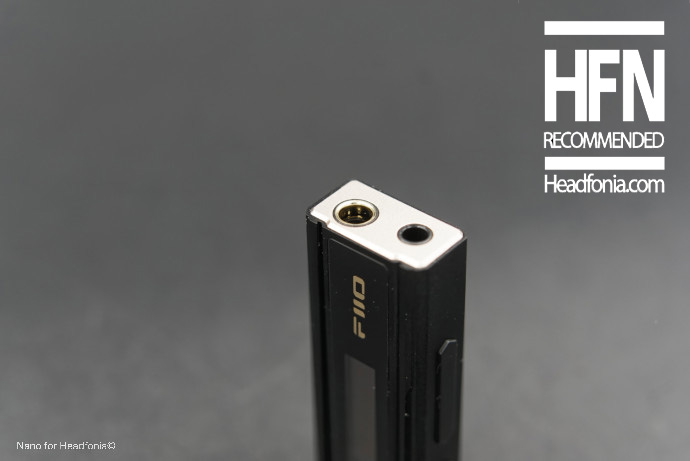

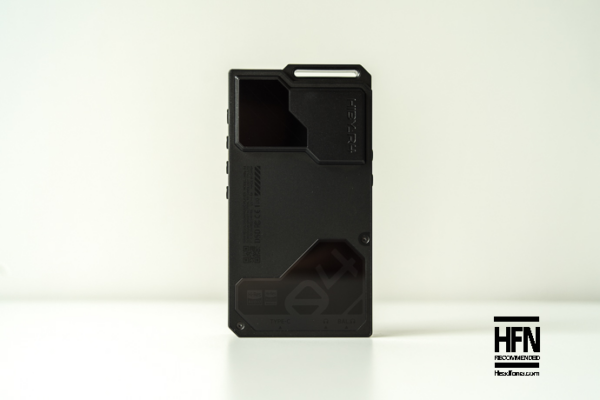
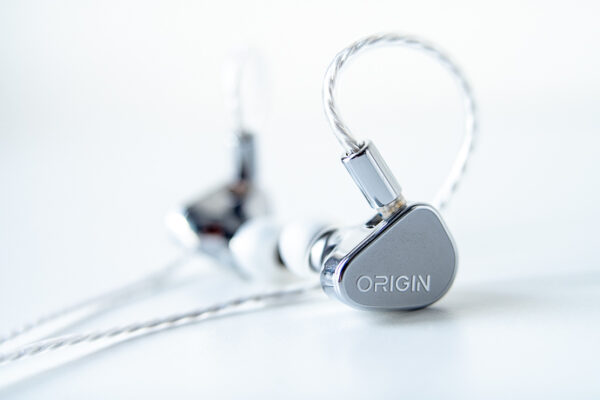
Tibor
Hi, thanks for the review!
If you can make a small shootout with more dongles, that would be great. Throw in Shanling UA3, iFi Go Bar and more. That would be very useful for the buyer, because we cannot get our hands on all of them.
Thank you!
Ken
How does it compare with the Hiby FC4 which is in the same price range?
Does it use a regular USB cable?(the FC4 does not so if the supplied cable fails, you can’t replace it)
Will the ever support MQA?
Sean
Bonus point fo the 3.5mm port that doubles as a SPDIF port (mini-toslink)
Fiio support tells me it is not toslink, but only coaxial output. Did you try either?
Mauro Loureiro
Great review. I like the quality and diversity of Fiio products, and let’s not forget their price wise. I had two Fiio iems and I still have the usb dac dc05, what a great pairing with my reecho sg03. Keep the good vibes flowing.
Lenebux
DAC USB Fiio KA5 Une introduction au menu Paramètres
1. GAIN : sélectionnez un gain élevé ou faible.
2. FLT : filtre numérique, 5 niveaux de filtrage sont disponibles.
3. VOL-CTL : contrôle du niveau de volume, 120 niveaux pour le mode A, 60 niveaux pour le mode B.
4. DAC-OM : le mode de sortie DAC, les modes ClassH et ClassAB sont disponibles.
5. SPDIF : une fois le mode SPDIF activé, vous obtiendrez le Signal SPDIF via le port 3,5 mm avec un câble adaptateur (acheté séparément). Veuillez garder cette option désactivée lors de l’utilisation de la sortie analogique, comme lors de la sortie vers écouteurs.
6. ADJ-L/R : paramètres de balance des canaux du canal gauche/droit.
7. H-DEPOP : affiche si le commutateur de mise en sourdine du matériel est activé. Vous pouvez définir si le commutateur matériel coupe la sortie.
lorsque vous changez de chanson pour améliorer le problème de son POP qui peut exister lors de la lecture sur certains appareils ou applications.
8. DIMMER : réglage du gradateur de l’affichage.
9. ROT-DISP : faire pivoter l’affichage. Il peut être réglé pour tourner à 180 degrés.
10. OFF-DISP : l’affichage peut être verrouillé automatiquement s’il n’y a pas d’activité, et le contrôle du temps peut être choisi entre 1 et 60 secondes. “NVR” signifie Jamais, c’est-à-dire que l’affichage ne sera jamais verrouillé automatiquement. *Remarque : l’écran OLED allumé en continu pendant une longue période peut entraîner des différences de luminosité. Ainsi, lorsque vous choisissez l’option “NVR”, il est suggéré d’appuyer deux fois sur le bouton multifonction pour éteindre l’écran lorsque vous n’avez pas besoin de le regarder.
11. HID-KEY : choisissez le mode A/B de Volume+ et Volume- boutons. 12. VERSION : affichage de la version du micrologiciel. 13. RST-DEF : restauration des paramètres par défaut.
Fonction de décodage expliquée 1. Utilisez un câble USB Type-C ou Lightning pour connecter le KA5 à un téléphone mobile, tablette PC ou autres appareils. *Un problème de compatibilité peut survenir sur certains téléphones portables ou lecteurs de musique en raison de différences de système et de matériel. ★Certains téléphones portables doivent activer la fonction OTG, afin d’utiliser le KA5 normalement. 2. Le KA5 fonctionne sans pilote sur les systèmes Windows 10 et supérieurs, ainsi que sur Mac OS. Vous pouvez installer le pilote USB sur votre PC, afin qu’il puisse prendre en charge le mode ASIO pour une meilleure expérience utilisateur. Veuillez télécharger le pilote USB sur notre site officiel : https://www.jadeaudio.com/supports ★ Le câble USB-A vers Type-C inclus dans l’emballage peut être utilisé lors de la connexion via le port USB-A. Lors de la connexion à un ordinateur, veuillez vous assurer que le “FiiO KA5” est utilisé comme périphérique de sortie audio. il fonctionne sous l’accès audio USB exclusif le contrôle du volume peut ne pas être disponible sur certains. Veuillez vous assurer que le niveau du volume est approprié en portant des écouteurs.
le KA5 est déconnecté et éteint, en tenant le bouton de fonction tout en le connectant à un appareil UAC1.0, 5 entrera en mode UAC1.0.
1.Filtre à atténuation nette à court délai :
Un filtre à atténuation nette à court délai, également appelé filtre brickwall, est un type de filtre numérique conçu pour atténuer rapidement les fréquences au-delà d’une certaine limite. Le terme “brickwall” (mur en briques) fait référence à la forme de réponse en fréquence de ce filtre, qui est caractérisée par une atténuation abrupte au-delà d’un point de coupure prédéfini.
Ce type de filtre est souvent utilisé pour éviter le repliement de spectre (aliasing) ou pour limiter la réponse en fréquence à une plage spécifique.
2. Roll-off rapide, filtre à compensation de phase:
1. Un “roll-off rapide” indique que le filtre appliqué dans le DAC atténue rapidement les fréquences au-delà de la bande passante souhaitée. Ce qui peut être bénéfique pour éliminer les fréquences indésirables ou prévenir le repliement de spectre.
2. Filtre à compensation de phase : Un filtre à compensation de phase est conçu pour minimiser les distorsions de phase introduites par le processus de filtrage. Lorsqu’un signal audio passe à travers un filtre, il peut y avoir des changements dans la phase relative des différentes composantes fréquentielles du signal. Un filtre à compensation de phase tente de maintenir la cohérence de la phase à travers la plage de fréquences, de sorte que les différentes fréquences du signal soient reproduites avec une relation temporelle précise.
Ces deux caractéristiques, un roll-off rapide et un filtre à compensation de phase, peuvent être présentes dans certains DAC haut de gamme pour améliorer la qualité sonore et la précision de la reproduction. Ils visent à réduire les distorsions, à contrôler la réponse en fréquence et à reproduire le signal audio aussi fidèlement que possible par rapport à la source numérique d’origine.
3.Filtre à atténuation lente à court délai:
Un filtre à atténuation lente à court délai, également connu sous le nom de filtre doux à court délai, est un type de filtre numérique Contrairement à un filtre numérique à atténuation nette à court délai (ou filtre brickwall), qui atténue rapidement les fréquences au-delà d’une certaine limite, un filtre à atténuation lente à court délai permet une transition plus douce entre les fréquences
tout en préservant davantage de détails et d’harmoniques dans le signal.
L’objectif d’un filtre à atténuation lente à court délai est de maintenir une réponse en fréquence plus étendue et d’offrir une reproduction audio plus chaleureuse et moins fatigante pour l’auditeur. Cependant, il convient de noter que les préférences en matière de son peuvent varier d’une personne à l’autre, et certains auditeurs peuvent préférer le caractère plus net d’un filtre à atténuation nette à court délai.
4.Roll-off lent, filtre à compensation de phase:
1. Roll-off lent : Le roll-off, dans le contexte du filtrage audio, décrit la façon dont un filtre atténue les fréquences au-delà d’un certain point de coupure. Un “roll-off lent” indique que le filtre appliqué dans le DAC atténue progressivement les fréquences au-delà de la bande passante souhaitée. Cela signifie que les fréquences hors de la plage de reproduction ne sont pas fortement réduites immédiatement, mais plutôt de manière progressive, préservant ainsi davantage de détails et d’informations harmoniques dans le signal audio.
2. Filtre à compensation de phase : Un filtre à compensation de phase vise à minimiser les distorsions de phase introduites par le processus de filtrage. Lorsqu’un signal audio traverse un filtre, il peut y avoir des changements dans la phase relative des différentes composantes fréquentielles du signal. Un filtre à compensation de phase tente de maintenir une relation temporelle précise entre les différentes fréquences du signal, de sorte que la cohérence de phase soit préservée et que la reproduction sonore reste précise et naturelle.
L’utilisation d’un roll-off lent et d’un filtre à compensation de phase peut contribuer à une reproduction audio plus douce, détaillée et naturelle. Les transitions entre les fréquences sont plus progressives, préservant davantage d’informations et réduisant les distorsions potentielles introduites par le filtrage.
5.Filtre sans suréchantillonnage
(non filtré ):
Il désactive complètement le filtrage numérique, offrant ainsi une réponse en fréquence complète sans modification.
Il est important de noter que la terminologie et les fonctionnalités spécifiques des filtres peuvent varier en fonction du modèle de DAC. Il est donc recommandé de consulter la documentation ou le manuel du DAC en question pour obtenir des informations précises sur les caractéristiques du filtre.